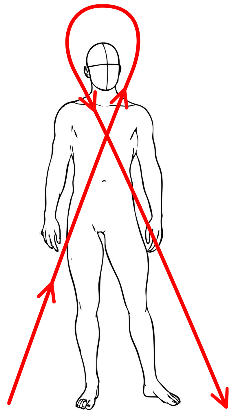Wechselhauw
Contents |
Change Strike
Meyer describes this as any strike which changes from above to below, left to right. Mair provides a more specific execution which we will include as it is very useful.
The change strike (not surprisingly) demonstrated the handwork known as changing (wechseln).
Longsword
Execution
An example of Meyer's execution of this technique is what he describes in other sections as Driving. For example, from a Wechsel position on the low left, slash up with the false edge diagonally to a Vom tag on the right, with a Gathering Step. Take another such step then cut back down with a Zornhauw back to the Wechsel position we began from. In this way we can clear the opponent's weapon out of the way and cut back in behind it.
Mair, on the other hand, describes a more specific action which covers the centre line with the blade in the follow up cut:
"When you come to the closing with the opponent and strike in the Wechsel (Changer), set your left foot forward and strike from below at his face such that the short edge stands high. Then step outward with your right foot and strike with the long edge to the right side of his head."
Essentially from Wechsel on the right (left foot forward) we slash up with the false edge along the lower-right to upper-left diagonal, then keeping the momentum of the sword going, and with a passing step forward and to the right, we cut back down along the upper-right to lower-left diagonal, which would end in wechsel on the left if we continued the cut through.
The pattern of the sword tip’s motion is show in the image.
Note that the slash can go all the way up to vom tag (creating a larger movement), or simply up to eisenport (a tighter, but less powerful movement).
Application
In keeping in line with Meyer's description of the strike (rather than Mair's used here) we could also use the strike with a slash up and slash down on the same line so that we slash up to the high right, then down from the high right back to the wechsel in which we started.
Application Example
In which the 'student' demonstrates their knowledge to the 'teacher'.
| Meister | Lehrling |
|---|---|
| Zornhut, left leg forward | Wechsel, right leg forward |
| Passing Step zornhauw | False edge slash up along the left to right diagonal, ending in Vom tag |
| Passing Step forward with the left foot, zornhauw to opponent's right upper opening. |
The application can also be demonstrated by driving forward and cutting along the same axis as follows:
| Meister | Lehrling |
|---|---|
| Zornhut, left leg forward | Wechsel, right leg forward |
| Passing Step zornhauw | False edge slash up along the left to right diagonal, ending in Vom tag |
| Gathering Step forward, zornhauw to opponent's left upper opening. |
Dussack
All cuts which go from one opening to another with the dussack are considered to be change cuts. For example an unterhauw followed by a zornhauw is a change strike.
